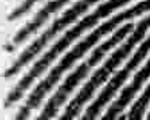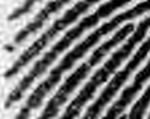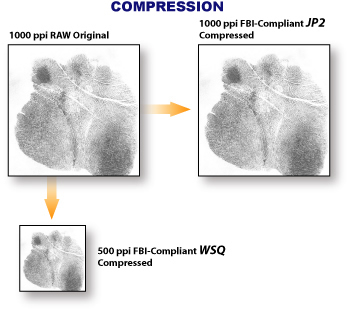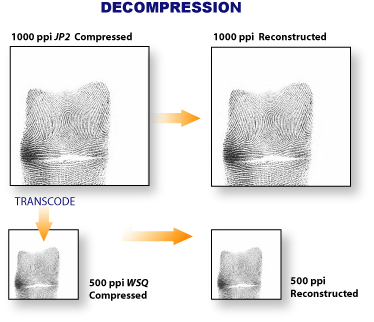Aware WSQ1000
High-performance, FBI-Certified WSQ compression of fingerprint images with JPEG 2000 compression and transcoding for 1000 ppi Images
Aware WSQ1000 is an SDK providing the industry’s highest-performing, FBI-certified implementation of the WSQ compression algorithm for fingerprint images. WSQ (Wavelet Scalar Quantization) is a wavelet-based compression standard designed and specified by the FBI for compression of high-resolution, 500 ppi grayscale fingerprint images. Aware WSQ1000 includes JPEG 2000 compression for 1000 ppi images and efficient transcoding between WSQ and JPEG 2000.
Aware WSQ1000 was the first commercial implementation of the gray scale fingerprint image compression standard. Its origins date back to 1994-1995 when Aware participated in a standards forum with US government agencies and several US universities to develop a lossy compression algorithm specifically for gray scale fingerprint data. A wavelet-based technique known as Wavelet Scalar Quantization (WSQ) was adopted.
Today, most of the world’s large, high throughput, fingerprint management and matching systems depend on Aware WSQ1000 to manage the compression and decompression of finger and palm image data. All finger and palm images submitted to the FBI are managed by Aware WSQ1000.
Features and Functionality
Runtime performance. Aware WSQ1000 is 4-5 times faster than most other WSQ implementations that share a common code base
Error resilience. Aware WSQ1000 has been exposed to and processed more images than any other implementation of the standard. It will not crash or bring a system down when presented with a non-compliant, truncated, very large, or unusually formatted image.
Dedicated support and maintenance. Aware WSQ1000 is a high quality commercial implementation designed and maintained by professional software engineers explicitly for demanding production environments
Continuous FBI compliance certification. All finger and palm images compressed with Aware WSQ1000 contain an encoder ID assigned by the FBI which is specific to the operating system and revision of the software. Compliance testing and certification is important because the purpose of the standard is to ensure minimal data loss of friction ridge detail. The WSQ standard is of minimal value without compliance assurance.
Support for 1000 ppi images. The FBI has published a standard for the compression and formatting of 1000 ppi fingerprint and palm images, called “Profile for 1000 ppi Fingerprint Compression.” This standard requires the use of JPEG 2000 for compression and formatting of 1000 ppi fingerprint images. WSQ will continue to be used for 500 ppi images. Like WSQ, JPEG 2000 uses a wavelet-based compression algorithm that performs particularly well for large images. It is an established ISO/IEC standard used extensively for applications involving large images including medical imaging, digital archiving, and digital cinema. The JPEG 2000 standards are complex, with many variable settings intended to help optimize its use for different applications. The FBI 1000 ppi profile includes several mandatory encoding parameters to ensure the optimization of JPEG 2000 for fingerprints. The FBI’s IAFIS and most legacy AFIS systems will continue to require 500 ppi WSQ compressed data. In order to enable 1000 ppi fingerprints to be used in both 1000 ppi and 500 ppi systems, Aware WSQ1000 enables efficient transcoding from 1000 ppi JPEG 2000 images to 500 ppi WSQ images.
SDK Features
Fingerprint and palm images can be compressed, decompressed, and transcoded between WSQ and JP2.
QualityCheck™
QualityCheck is an advanced fingerprint image quality scoring software library included in SequenceCheck and Aware WSQ1000 SDKs. QualityCheck uses advanced algorithms to assess whether a fingerprint image is of sufficient quality for biometric matching. QualityCheck implements a specific measure of finger image quality that is based on the continuity of ridge flow across all regions of a finger image, and returns information based on the following factors:
- Image smudges due to movement, improper finger placement, or excess moisture
- Image darkness due to excess pressure
- Image lightness due to inadequate pressure
- Mis-calibrated sensor
- Small image
- Missing core or delta
- Relative quality as compared to other images
QualityCheck generates an overall score between 0 and 100, and provides information on areas of the image that exhibit problems. These areas are returned to a software application as arrays of pixel regions or as a color-coded image of the finger, which indicates the specific problems with the finger image. This functionality can improve the ability of an operator to screen bad images.

JPEG (15:1, x4 zoom). Note block artifacts.

WSQ (15:1, x4 zoom). No block artifacts.

